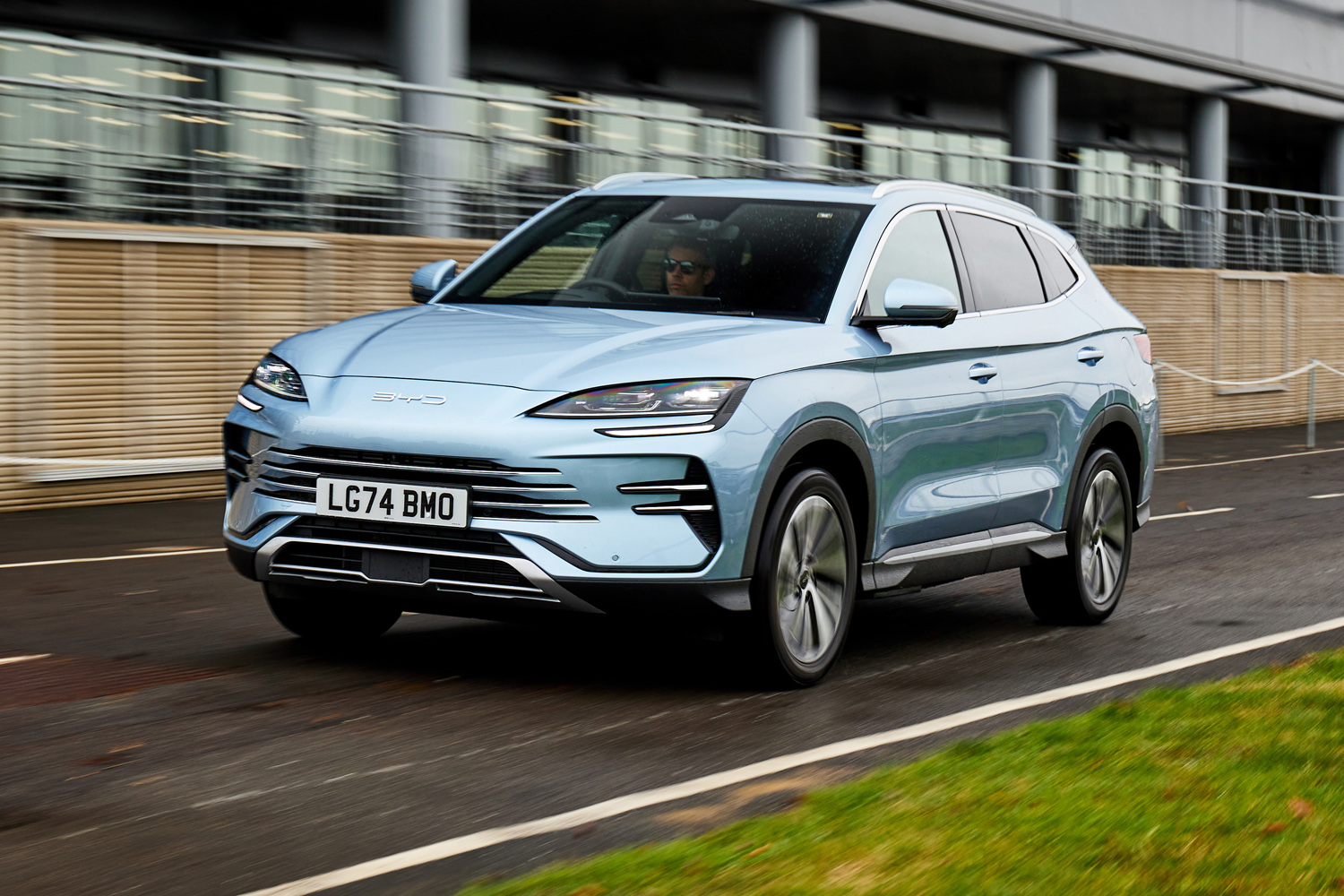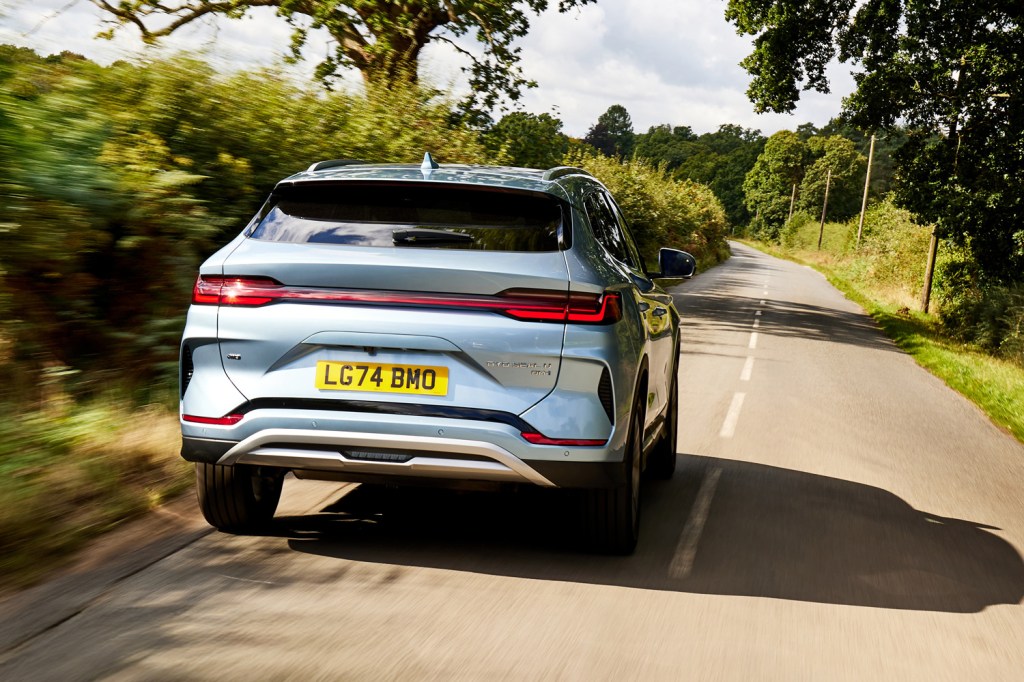Introduction
European car shoppers have no shortage of hybrid SUVs from long-established brands to choose from. There’s the not-quite-fully-electric Nissan Qashqai E-Power and Renault Austral E-Tech, or the plug-in Ford Kuga PHEV, Kia Sportage PHEV and very good Skoda Kodiaq PHEV to choose from. Can Chinese upstart BYD possibly tempt them away?
As you’d expect, the Seal U PHEV puts an emphasis on providing value. The four-wheel drive Design model seen here will set you back £39,905, while the cheaper, front-drivne Boost edition kicks off the range at £33,205. Both offer a high level of trim and kit for the cash, especially compared to the pricier alternatives mentioned above.
I enjoyed BYD’s Dolphin electric hatchback and Seal EV saloon, which cover different segments than this family-focused SUV. As a plug-in hybrid, does it appeal to those not quite ready to take the plunge on a purely battery-powered car?
The styling
It’s hard to ignore the slight whiff of Porsche emanating from the front end of the BYD Seal U. Unfortunately, while there’s a similarity, that’s where the premium appeal tails off – this is a rather bland looking SUV viewed from most other angles. Everything is designed with practicality in mind and works as expected, but the excitement levels from those high-up lines are minimal. I think things would be helped if BYD offered the Seal U in zestier colours, only they don’t and as a result it’s a bit soulless.
Take a tour around the Seal U and there’s very little else that stands out compared to the nose of the SUV. The taillight bar across the backend works well enough, but this is also pretty generic. Sandwiched in-between is a profile that’s reasonably forgettable, with only some tasty alloys helping to lift the look overall. I don’t dislike the look of the Seal U, but I wish it had a little more going for it other than generic SUV styling lines.
Things pick up with the interior. This is a light and airy place, with the cockpit occupants getting treated to the best bits. There’s a sizeable touchscreen, plenty of ports for charging and comfortable Vegan leather seats. In fact, BYD seems to have worked hard to make the cockpit area feel reasonably premium although at the same time the seat coverings feel like they’ll be durable enough to take on the assault of family life.
The drive

BYD’s engineers to have made the Seal U DM-i drive a lot like a full-blown EV a lot of the time. The all-wheel drive model seen here has an electric motor on each axle, while the turbocharged 1.5-litre petrol engine helps maintain a minimum 25% charge. That means the 18.3kWh battery is ready to offer up to 43 miles of range when the circumstances permit.
There’s clearly quite a lot of clever stuff going on between the various core components, and sure enough, as a result, I found it was always able to keep some juice in the battery – unlike some PHEVs that use up what they have, and the car then relies solely on the petrol engine until it’s charged again. This feels like a cocktail of cleverness is going on to make sure that doesn’t occur.
It’s an easy thing to drive too. Eco, Normal and Sport modes are on offer, but to be honest there’s not a whole lot to differentiate between them. This is compounded by the incredibly spongy ride, which I found to be a little disconcerting as I bumped and bounced my way around Hampshire lanes. It really is so soft that the BYD Seal U DM-i doesn’t feel very predictable and actually quite unwieldy. More taught suspension please.
The other issue is the vagueness of the steering, which is light to the touch and makes manoeuvring around car parks easy enough. Less impressive is the way it works in tandem with the sloppy suspension to provided reassurance on both motorways at speed and undulating B-roads with unpredictable surfaces. The BYD Seal U DM-I goes and stops well enough for a biggish SUV, but the bit in-between needs some attention, I think.
The technology
While the BYD Seal U DM-i might lack charm, it’s big on tech with the same levels of infotainment action as seen on the saloon version of the Seal. The central touchscreen looks quite good, although it somehow lacks the same punch as that seen in other premium SUVs. Nevertheless, the 15.6in screen had everything I needed to get through my day, although I struggled with some of the climate controls and suchlike that were embedded within it. It’ll rotate 90-degrees if you prefer landscape to portrait too, as per the regular Seal. The twin wireless phone charging was a boon, too.
The steering wheel offers some control options too mind while the 12.3in display in front of that looks okay too. My test car benefitted from a head-up display, which once I’d got it set to the right level seemed to be pretty effective. Elsewhere, the sound system offers a fairly standard audio experience plus there’s Vehicle-to-Load functionality that allows you to power, say, a laptop or coffee machine should you fancy it. Overall, then, this is an SUV that ticks all the boxes on the tech front, without ever wowing along the way.
BYD Seal U DM-i verdict


I really enjoyed my time with the saloon version of BYD’s Seal, but the Seal U DM-i incarnation feels less impressive. It’s been put together well enough, and the powertrain is quite an interesting proposition. However, it falls down in the driving department mainly because of the super-soft suspension, which I found difficult to get on with.
Nevertheless, as SUVs go, it’s got everything a buyer might need – and the price isn’t bad either.
BYD Seal U DM-i technical specifications
| Powertrain | 1.5 litre petrol/Permanent magnet synchronous motor |
| Battery | 18.3kW |
| Power | 362bhp |
| Torque | 369lb ft |
| 0-60mph | 5.9sec |
| Top speed | 112mph |
| Range | 600 miles (combined) |
| Charge rate | 18kWh |
| Cargo volume | 425 litres |






